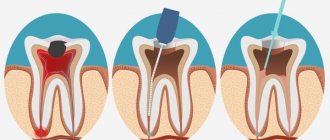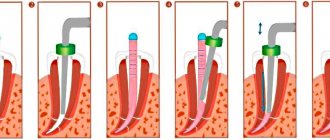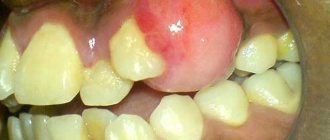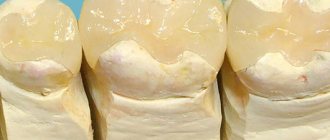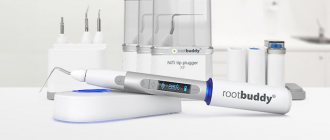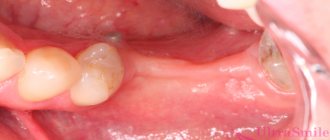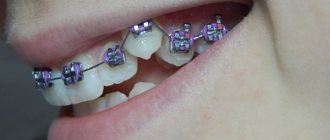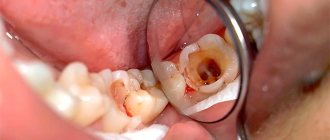Resorcinol-formalin method or the story of one tooth. Patient's view.
The possibility of using formaldehyde in dental treatment was considered back in the century before last.
In the early twenties of the last century, the German doctor Albrecht proposed resorcinol-formalin paste for these purposes. The method is quite inexpensive and does not require special skills for a specialist. In the past it was very popular, and therefore was used in almost any case of dental treatment.
The essence of the technique is to apply a resorcinol-formalin mixture to the affected pulp, which makes it possible to stop its further decomposition, since the paste has bactericidal and mummifying properties. At that time, it was believed that formaldehyde hardened the collapsed cavity and sealed it. This method originally contained five steps, but over time it was reduced to three.
Despite the already formed negative attitude towards this method, it continues to be used in some clinics. The explanation for this fact lies in its low cost and ease of execution.
The patient who finds himself in the dental chair completely trusts his doctor in choosing treatment tactics, since he himself does not have the necessary knowledge for this, so it is advisable to clarify before the start of medical procedures how they will be carried out. A competent specialist will never harm the patient’s health for the sake of cheapness.
N.I. KUDRYA, specialist of the medical standards department
Probably every person at least once in his life has had to deal with a toothache that does not go away for a minute, gets worse from hot, cold and becomes especially severe at night. This happened to me once too. I tried to relieve the pain with a pill. But neither after the first nor after the second pill the pain disappeared. After spending the night, I went to the dentist in the morning. The doctor diagnosed it as pulpitis.
Pulpitis is the result of penetration of pathogenic microbes into the dental pulp, causing its inflammation. Pulp is the loose soft tissue that fills the dental cavity, consisting of many nerves, lymphatics and blood vessels.
Sitting in the dental chair, I thought only about one thing - to quickly get rid of this torment. Then I didn’t even think about what method I would be treated with. At that time, pulpitis of chewing teeth was treated in one way. A paste containing arsenic was placed into the tooth pulp. The patient left only to return 2–3 days later.
Once, during a routine examination, the dentist recommended that I put a crown on that same tooth. I agreed. The doctor also advised me to treat the root canals to make sure that there are no inflammatory processes in them. To do this, it was necessary to unseal the canals, treat them instrumentally and medicinally, and seal them again.
During the retreatment, I learned that my tooth had previously “tested” the resorcinol-formalin method. It turned out that it is now impossible to properly treat the canals. The paste that was in the tooth cavity has turned into a solid mass that cannot be passed through with an instrument. In the end, the tooth was “crowned” with a crown with no guarantee that future complications would not arise.
I wanted to know more about the resorcinol-formalin method. At that time, not being a doctor by training, I was already working in a dental center and could get information from personal conversations with specialists.
The method of filling canals using formalin saturated with resorcinol was proposed in 1912 by Dr. Albrecht. According to the author, the mixture had bactericidal and mummifying properties. Followers began to believe that the mixture solidified in the channels, reliably sealing them. For that time it was a truly progressive method, because...
Today, practice shows that resorcinol-formalin paste does not always completely fill the canals, and this can be seen on x-rays. Foci of inflammation remain, which leads to complications and the need to re-treat the tooth. The retreatment process is quite complex and not cheap for the patient. In addition, the likelihood that retreatment will be successful is low.
There is also an aesthetic drawback - the “resorcinol-formalin” tooth acquires a pinkish-brown tint. In addition, the dangers of using the resorcinol-formalin method have been proven by many years of research. Formaldehyde and resorcinol are toxic substances. Formaldehyde, the active ingredient in formalin, gradually spreads throughout the human body and has a negative effect on the reproductive organs, central nervous system, respiratory tract, skin, and eyes.
In many countries around the world, the use of the resorcinol-formalin method in dentistry is prohibited. For example, in Switzerland it has not been used for more than 70 years. In the United States, a doctor who offers this method to a patient is deprived of his license. In our country, some municipal dental clinics still use the resorcinol-formaldehyde method of root canal treatment, despite the fact that safer and more reliable methods exist. The reason for its indestructibility is the same cheapness and the lack of opportunity or desire among Russians to pay for high-quality dental treatment.
It often happens that a person is faced with the need to make a choice that is difficult to make correctly without having the necessary information, especially when it comes to health. In this article, I wanted to talk about the resorcinol-formaldehyde method, without using medical terms, from the perspective of a patient who has experienced the consequences of its use. I hope I succeeded.
History of the resorcinol-formalin method of dental treatment
The resorcinol-formalin filling method was invented in 1912 by Dr. Albrecht and for a long period of time was the most popular in dentistry. It belongs to the so-called impregnation methods, that is, it is based on impregnation of the contents of the impassable part of the root canal in order to achieve its asepticity.
The basis of the resorcinol-formalin method was the mummifying and bactericidal properties of this mixture, due to which the decay of the pulp was stopped and the infected canals were sealed. The mixture contained resorcinol (a phenol derivative) and formaldehyde. The advantage of the mixture was considered to be the disinfecting properties of formalin and its pronounced antiseptic effect. The resorcinol-formalin mixture filled the root canals, mummified the pulp and dentin, disabled the nerve, and the tooth was considered cured.
Being relatively inexpensive and technically easy to implement, the method has become widespread in dental practice and was often used by dentists in Soviet times to treat molars. Today, the resorcinol-formalin method has practically gone out of use, since many modern and safe methods for human health have appeared, dentists are trying to move away from the use of impregnation.
What is the resorcinol-formalin treatment method?
The resorcinol-formalin method of dental treatment belongs to the classical impregnation technique. Used for root canal filling.
The therapeutic mixture consists of two components: resorcinol and formalin. With its help, filling is performed in several stages. First, completely passable canals are subjected to this, then the procedure is repeated with the rest along the maximum possible length, after which the orifices are drilled out and the necrotic pulp is removed. Impregnation of a resorcinated tooth takes place in three stages.
First stage
To get started, formaldehyde-resorcinol paste is prepared. Exactly 5 drops of formalin are applied to a special glass. Resorcinol is gradually added to it until completely dissolved.
The patient is in the dental chair. When manipulating teeth on the lower jaw, the person is in a sitting position, on the upper jaw - with his head thrown back. This is necessary to prevent the solution from getting on healthy tissue.
We invite you to familiarize yourself with Neuralgia of the facial nerve. Symptoms and treatment, folk remedies, drugs
Afterwards, the root canal is impregnated with paste, for which:
- accumulated saliva is removed;
- apply 2 drops of paste with a pipette;
- a substance is injected into the affected part of the canal with a special instrument;
- its excess is removed, the procedure is repeated two more times;
- if the mouth of the canal is impassable, then a tampon soaked in a resorcinol-formalin solution (without using a catalyst) is applied;
- A dense dentin bandage is applied.
Second phase
It is carried out after a short time, most often two to three days after the first stage. The dentin bandage is carefully removed, and then the tooth is re-impregnated using the same technique (without using a catalyst). The next visit is scheduled for the patient in two to three days.
Third stage
To carry it out, it is necessary to re-prepare the paste and then add a catalyst to it. Usually it is chloramine or sodium hydroxide solution.
The canal is treated with the resulting mixture, after which the resorcinated tooth is filled, at the mouth of which a phosphate-cement spacer is applied. A permanent filling material is applied to the crown.
Resorcinol-formalin filling method
In this case, doctors carry out the procedure in several stages, gradually preparing and filling the canals along the entire length. In the process, the mouth is drilled out, and then the remains of the damaged pulp are necrotic. The manipulations are performed in the dentist’s office according to medical indications in three visits.
First session
First, the specialist prepares the solution itself:
- Exactly 5 drops of formalin are placed on a glass plate.
- Next, resorcinol is added until the main substance completely absorbs it.
At this time, the patient should position himself in a chair in such a way that it is convenient to apply the soaking solution. So, if the teeth on the lower jaw need filling, then he should sit straight, and when treating the upper row, you need to lie down and tilt your head back strongly.
The procedure itself goes as follows:
- dry all surfaces of the oral cavity, remove saliva;
- using a pipette, squeeze out no more than two drops of the resulting medicinal mixture;
- using an endodontic instrument, it is brought deep into the affected tooth along the entire length of the canal;
- excess solution, if any remains, is removed with a cotton swab;
- repeat actions up to three times;
- if it is impossible to directly reach the mouth, for example, as a result of a complex and tangled root system, moisten a swab in a resorcinol-formalin solution and apply it to the treated area;
- At the end, the unit is tightened with a special dentin bandage and the patient is sent home.
Second
Your next visit to the dentist's office is scheduled in a few days. The doctor removes the applied bandage and repeats all the steps described above. The root canal is additionally impregnated with a resorcinol-formalin mixture.
Third
This time, the specialist must prepare a similar solution, but a catalyst is added to it - three drops of chloramine or no more than two drops of 10% sodium hydroxide. Using this paste, the root canal is finally filled.
A phosphate-cement gasket is placed at the mouth and a permanent filling material is fixed, tightly closing the treated cavity.
The essence of the method
The resorcinol-formalin mixture has bactericidal and mummifying properties, so its introduction inside the canal stops pathological processes in the pulp, even if it cannot be completely removed. Once the mixture is left there, it gradually hardens without expansion or loss of volume, and the channels remain sealed for years.
To perform such treatment, you do not need special skills or high professionalism, or specialized equipment. In Soviet times, this method was used in more than 80% of cases to eliminate diseases of the premolar pulp. Now the technique is falling out of use, in some countries it is prohibited at the legislative level.
Is this method used in modern dentistry?
Despite the already formed negative attitude towards this method, it continues to be used in some clinics.
The explanation for this fact lies in its low cost and ease of execution. The patient who finds himself in the dental chair completely trusts his doctor in choosing treatment tactics, since he himself does not have the necessary knowledge for this, so it is advisable to clarify before the start of medical procedures how they will be carried out. A competent specialist will never harm the patient’s health for the sake of cheapness.
How is this harmful to teeth and gums?
In almost all countries of the world, this method has been prohibited for use for more than half a century. The main risk factors for using resorcinol-formalin mixture include:
- The danger of the paste composition affecting the body. Formaldehyde and resorcinol contained in it have toxic and carcinogenic properties. Penetrating from the dental canal into the blood, formaldehyde enters vital organ systems and negatively affects them. There is evidence that under its influence irreversible consequences can occur, including the development of oncology.
- There is a possibility that the paste will not completely fill the canals, which is why another inflammation is possible in already completely sealed conditions. Due to necrotization of the pulp, the infectious process occurs latently, this can lead to the formation of cysts and abscesses on the root of the diseased tooth, as well as to their spread. Therapy of resorcinated teeth is difficult, since inflammation is not immediately diagnosed on an x-ray, and the pathology is often detected in an advanced stage.
- The acquisition of a yellow, brown or pinkish color by the tooth enamel due to the effect of the mixture on the dentin. Whitening enamel after such treatment is a very difficult task even for professionals.
- Reduced strength and elasticity of tooth tissue. Although dentin is a fairly hard substance, formalin and resorcinol affecting it reduce its quality characteristics. The patient is forced to go to the dentist again for help, since resorcinated dentin has a deteriorated structure. Subsequent manipulations cause certain difficulties, since destroyed tissues easily crumble.
History and description of this filling method
Methods based on impregnation have been valued by dentists for quite a long time for their, as it seemed then, undeniable advantages. Likewise, the resorcinol-formalin method is loved by dentists for its simplicity, low cost and speed of implementation. In the 2nd half of the twentieth century, this method was widely used by most dentists for the treatment of molars (chewing teeth), especially in outpatient practice. Easy to implement and not requiring significant financial expenditure, it was ideal for clinics with their huge daily flow of people. Fortunately, these days it has practically fallen out of use among dentists and is synonymous with an unprofessional attitude towards dental treatment.
Alternative treatments include:
- filling canals with one paste;
- lateral condensation method;
- Gutta-percha injection technique;
- single pin method.
The Russian Dental Association decided to exclude the resorcinol-formalin method from clinical recommendations for dentists, and also demanded its exclusion from the curriculum of medical universities in Russia. However, sometimes this filling method is still used. Basically, these are insufficiently qualified specialists in cheap dental clinics. If you go to the dentist and he offers you a resorcinol filling, you need to run away from this clinic as fast as you can and look for another doctor who is familiar with new modern filling techniques.
More recently, the resorcinol-formaldehyde method of dental treatment was used in dentistry. Senior teachers at medical universities, experienced specialists, our parents and grandparents can remember him. At that time, this method seemed almost the only correct and possible method for filling canals.
Let's figure out why such treatment was abandoned today and how successful discoveries in the past turned out. Indeed, in modern medicine it is strictly forbidden to use this composition in any public or private institutions.
The possibility of using formaldehyde in dental treatment was considered back in the century before last. In the early twenties of the last century, the German doctor Albrecht proposed resorcinol-formalin paste for these purposes.
The method is quite inexpensive and does not require special skills for a specialist. In the past it was very popular, and therefore was used in almost any case of dental treatment.
The essence of the technique is to apply a resorcinol-formalin mixture to the affected pulp, which makes it possible to stop its further decomposition, since the paste has bactericidal and mummifying properties. At that time, it was believed that formaldehyde hardened the collapsed cavity and sealed it. This method originally contained five steps, but over time it was reduced to three.
Advantages and disadvantages
The resorcinol-formalin method is widely used due to the following factors:
- ease of preparation of the medicinal mixture;
- confidence in the safety of the reagent at the time of development of the method;
- simple treatment technique;
- accessibility due to the low price of the composition.
Among the disadvantages are:
- the need for re-intervention in more than 75% of cases after just a few years;
- a complication of diagnosis, since in X-rays the channels filled with resorcinol-formalin composition look hollow;
- increased fragility and fragility of dentin after exposure to formaldehyde and resorcinol;
- detected harm to the patient's health.
How is this harmful to teeth and gums?
Studies have confirmed that exposure to resorcinol-formalin mixture poses both local and general health risks. After hardening, due to the disabling of the nerve, the pain disappears, but this does not mean the complete destruction of all pathological foci. The body is simply no longer capable of a natural reaction in this place - pain.
After placing the resorcinol-formalin composition into the canal, slow gum atrophy occurs, the soft tissues near the tooth subside, and the root neck is exposed. Due to the fact that formalin is very hygroscopic, it draws fluid from the bone tissue, so the dentin and root become brittle and brittle. By the time tangible signs of inflammation appear, it is difficult to re-treat, since the fragility of the tissue prevents it from being properly dissected, and there is a high probability that it will crumble in the process. For the same reason, removal is also complicated.
Substances included in the resorcinol-formalin composition cause darkening of dentin and enamel. Most often there is a pink or brown tint. It is impossible to whiten such a tooth using existing methods, since the darkening is concentrated not on the surface, but in the very structure of the bone tissue.
Premolars treated in this way cannot be used as a support for installing a permanent denture - this is hampered by increased fragility, so you have to choose uncomfortable removable dentures.
But the mixture has the greatest harm on the general condition of the body. This harm cannot be assessed objectively, since the consequences are strongly separated from the moment of treatment and have not previously been associated with each other. However, numerous experiments and studies have confirmed how extensively resorcinol-formalin solution affects health.
Resorcinol in cosmetics
Resorcinol, also known as resorcinol, is a well-known and powerful ingredient that should be used with extreme caution. Resorcinol is used to treat many skin problems, and also in skin or hair cosmetics as... an enhancer that improves the color of the product.
Synonyms: Resorcinol, Phenylethyl Resorcinol, (E)-5-(p-Hydroxystyryl)resorcinol, 2-Methyl Resorcinol, 4-Chloro Resorcinol, 4-n-Buryl Resorcinol.
Patented formulas: Jarocol RL, PromaCare® PS, Wilshire Technologies Resveratrol, Vivinol, MultiSal™ Triple-Action Anti-Aging (TAAA), SymWhite® 377, Hentowhite.
Resorcinol is a component of therapeutic agents and hair dyes 18987
Effect of resorcinol in cosmetics
Essentially, resorcinol is an antiseptic (it coagulates proteins, which causes the death of vegetative forms of microorganisms, although it has a weak effect on spores), however, the effects of this substance are so diverse that in cosmetology it is used to solve a huge number of problems.
For example, resorcinol inhibits melanin pigmentation, thereby blocking the appearance of freckles; reduces ultraviolet-induced pigmentation by quickly and deeply penetrating the skin: this is an extremely active component, which can also be dangerous. Resorcinol effectively prevents melanin synthesis, improves skin texture by smoothing out unevenness, and reduces pigmentation caused by ultraviolet radiation. Resorcinol acts not only as an antibacterial or whitening agent, but also as an antioxidant and anti-wrinkle agent. Some resorcinol derivatives (Phenylethyl Resorcinol) have shown to be one of the most active tyrosinase inhibitors with a 22-fold effect of kojic acid. This ingredient reduces the formation of melanin at a very early stage of melanin synthesis and melanosome transfer to keratinocytes. Promotes desquamation of the superficial stratum corneum and the melanin pigment residues contained in them.
As you can see, the properties of resorcinol and its effect on the skin are very diverse, but they are, so to speak, highly specialized, and it is better to use cosmetics with these components under the supervision of a dermatologist.
Who is resorcinol indicated for?
Resorcinol is a serious therapeutic substance that is used for the following problems and diseases:
- eczema;
- neurodermatitis;
- seborrheic dermatitis;
- chronic inflammation of hair follicles;
- hyperpigmentation;
- severe itching of the facial skin;
- pathological hair loss, which can lead to thinning or complete baldness (alopecia).
Western manufacturers, using resorcinol, rely mainly on the fact that it provides active skin lightening, whitening and removal of age spots. Cosmetics based on it are used for whitening, treating signs of chronological aging, photoaging, lightening the skin of the face, hands and bikini area, as well as for caring for aging skin.
In some cases (decorative cosmetics, hair dyes) this component has no indication, since it is an auxiliary substance (dye).
For whom is resorcinol contraindicated?
Resorcinol is one of those substances whose use in cosmetology is surrounded by many legends. Its medicinal properties are quite interesting, but it is almost impossible to find facial skin preparations based on this compound on sale. The main reason is the very high risk of side effects. These include: swelling; hives; severe irritation of facial skin; increased sweating, cyanosis, or other change in facial skin tone.
Important: resorcinol is incompatible with menthol, phenyl salicylate, phenol, camphor, antipyrine and salicylic acid. This component should not be used during treatment with drugs that have an alkaline reaction. When using it as a medicine, it should be taken into account that dust or vapors of resorcinol irritate the skin and mucous membranes of the eyes and respiratory tract and cause coughing. Strict contraindications include individual hypersensitivity reactions, extensive lesions of the skin and mucous membranes, violations of the integrity of the skin, as well as pregnancy and lactation.
At the same time, hypoallergenic, free of toxic additives and safe to use forms of resorcinol have been developed (for example, 4-n-Buryl Resorcinol). This compound, based on a derivative of the resorcinol molecule, has outstanding results in reducing the appearance of dark spots on the skin and whitening the skin, without exhibiting any of the irritating effects associated with standard resorcinol.
Cosmetics containing resorcinol
Resorcinol is used to treat many skin problems, as well as in cosmetics for the skin and hair (including hair dye compositions), and in decorative cosmetics. According to the European Union Regulation, the maximum permissible concentration of this component in finished cosmetic skin care products is 0.5%.
Sources of resorcinol
Resorcinol is synthesized artificially - it has the same composition as pyrocatechol and hydroquinone, differing from them only in the relative arrangement of hydroxyl groups. It is colorless crystals that are easily soluble in water and ethanol; in solution they have a very specific odor.
Similar treatments
Today there are a sufficient number of methods that do not have a negative impact on health. Most often used:
- pin method;
- use of gutta-percha;
- lateral condensation;
- filling canals using a special paste.
These materials fill the cavity as tightly as possible, preventing the filling from falling out. At the same time, they are resistant to natural body fluids. Installed instantly due to rapid hardening. Unlike the resorcinol-formalin method, they do not stain the tooth enamel, ensuring its aesthetic appearance. In addition, this treatment is absolutely safe and highly effective.
Stages of treatment
The resorcinol-formalin treatment method is carried out in several stages. It requires a minimum of three visits to the dental office.
First visit
All manipulations that are performed using this method on the first day, in the case of baby teeth, are recommended to be carried out without injection anesthesia. Sometimes parents ask to numb the area if the child is very afraid and has a low pain threshold. In adults, local anesthesia is used, since the roots go deeper and are treated on a larger scale.
The tooth cavity is opened using a drill. A resorcinol-formalin mixture is prepared from a few drops of formalin and a small amount of resorcinol powder. The paste is mixed until smooth using a metal spatula. Before applying the paste, the tooth is isolated from saliva and thoroughly dried, and then a solution is placed into the canal.
We invite you to familiarize yourself with the bump on the cheek from the outside
At the end of the first stage, the dentist installs a temporary artificial dentin filling and schedules a follow-up visit in a day or two. This time is enough for the substance to take effect.
Second visit
Since the nerve has already been killed by the second visit, anesthesia is not used. The temporary filling is opened, the medicine placed for the first time is removed along with the pulp, and the paste is again applied to the empty root canals. The cavity is sealed with artificial dentin.
Third visit
The temporary filling is opened. At the final stage, a catalyst - chloramine or caustic soda - is added to the paste to resorcinol-formalin to speed up disinfection inside the cavity. The canal is tightly filled with this composition, and then the tooth is filled with a permanent filling. The coronal part is restored while maintaining the anatomical shape.
In rare cases, the dentist decides that three fillings are not enough, then a fourth visit is scheduled, and a permanent filling is installed only for the fourth time.
In 1912, the German doctor Albert proposed a new method for treating infected tooth canals, which involved the use of resorcinol-formalin paste. It was believed that the latter has bactericidal and mummifying properties that can stop the decay of the pulp. This made it possible to seal and clean the dental canal from pathogenic microflora.
The essence of this method is to transform the pulp into a plastic-like aseptic strand, which would not be subject to dissolution under the influence of tissue microflora. Therefore, in order to avoid the development of “residual pulpitis,” the pulp must be devitalized before impregnation begins.
Filling canals using Albrecht technology is carried out in several stages. At the preparatory stage, attention is paid to filling the root canals, which were managed to pass along the entire length. Others are filled in to the extent possible. Then, to necrotize the tissue remnants of the damaged pulp, the mouths of each of them are drilled out. Three sessions are allotted for all manipulations.
At this stage, the specialist is preparing the solution. Start making a paste with 5 drops of formaldehyde, for which a glass plate is used. Afterwards, resorcinol is gradually added to it. Thorough stirring ensures its complete absorption by formaldehyde.
During impregnation, the patient must be placed in the dental chair in a position that would allow the impregnation solution to flow into the canal under the influence of gravity. Filling the teeth of the lower jaw requires an even fit, while a lying position with the head tilted back will be required in the case of treatment of teeth in the upper jaw.
The patient's next session awaits a few days later. The doctor removes the dentin bandage and re-does all the manipulations that the affected areas were subjected to during the first procedure. Thus, they are additionally impregnated with resorcinol-formalin mass.
Then the solution used is modified. A specialist adds a catalyst to it on a pre-prepared glass plate. The latter is represented by 3 drops of chloramine, in other cases - 2 drops of sodium hydroxide. The prepared mixture completely seals the affected canal. Its filling with resorcinol-formalin substance is brought to the state of a tight mass.
Resorcinol-formalin method: preparatory stage
The essence of this method is to transform the pulp into a plastic-like aseptic strand, which would not be subject to dissolution under the influence of tissue microflora. Therefore, in order to avoid the development of “residual pulpitis,” the pulp must be devitalized before impregnation begins.
Filling canals using Albrecht technology is carried out in several stages. At the preparatory stage, attention is paid to filling the root canals, which were managed to pass along the entire length. Others are filled in to the extent possible. Then, to necrotize the tissue remnants of the damaged pulp, the mouths of each of them are drilled out. Three sessions are allotted for all manipulations.
At this stage, the specialist is preparing the solution. Start making a paste with 5 drops of formaldehyde, for which a glass plate is used. Afterwards, resorcinol is gradually added to it. Thorough stirring ensures its complete absorption by formaldehyde.
During impregnation, the patient must be placed in the dental chair in a position that would allow the impregnation solution to flow into the canal under the influence of gravity. Filling the teeth of the lower jaw requires an even fit, while a lying position with the head tilted back will be required in the case of treatment of teeth in the upper jaw.
Caries on a wisdom tooth: treat or remove
Many people have known since childhood that “wisdom” molars are an atavistic heritage. Then the information is laid down that these are molars that are unnecessary for a person, and they need to be removed immediately after eruption. Competent dentists today do not support this opinion.
The situation needs to be viewed from two perspectives.
- Should wisdom teeth be removed if they don’t bother me? Definitely no. Especially if the molars are paired - there is both an upper and a lower one, and also in the absence of mobility, caries and even growth in the dentition.
- Hole in wisdom tooth – treat or remove? It's a little more complicated, but there are more reasons to preserve the third molar than to extract it.
No dentist will answer the question “wisdom tooth caries – treat or remove” without examining the patient. The decision to save a molar is accompanied by an objective assessment of many factors. The doctor looks:
- The degree of damage is the number of caries lesions, their location, and the presence of other dental problems. It happens that a patient comes with “caries,” but in reality it turns out that the carious process has already gone far. And here several options are possible - pulpitis, periodontitis, cyst, wisdom tooth granuloma.
- Location under or above the gum tissue - retracted and semi-retracted teeth often bother patients, but it is not difficult to solve this problem with modern medicine.
- Quality of growth. Wisdom teeth do not always grow straight. Sometimes it interferes with chewing, injures the soft tissues of the cheek, and serves as a constant source of discomfort.
Studying all aspects of the disease, painstaking and accurate diagnosis will help the doctor make a decision on treatment and select the optimal sequence of manipulations.
The decision has been made - we need to treat. Often such information leads the patient to panic, expecting pain and discomfort. Don't worry. Complete painless treatment is guaranteed by modern equipment and the professionalism of the doctor.
When sanitation of the oral cavity, the dentist uses:
- Modern equipment. Installation with a bur rotation speed of 150, 300, 500 rpm with forced water-air cooling of the tip guarantees the absence of unpleasant vibration, eliminates overheating of the tooth, and almost completely eliminates pain. Allows treatment without anesthesia, but for hypersensitive and panicking patients, pain relief remains a necessity.
- High quality anesthesia. There are many options. The choice depends on the skills and knowledge of the doctor and the equipment of the clinic. You can “freeze” half of the patient’s face for 6-8 hours or deprive the patient of discomfort in the local area for 40-60 minutes, which is necessary for the treatment of wisdom tooth caries. Infiltration anesthesia - intraligamentary and intraseptal - for high-quality “freezing” is used in clinics of a high level of service. Monitoring the professionalism of dentists and their frequent training ensure full mastery of complex anesthesiological techniques.
The use of modern treatment methods makes it possible to get rid of even pulpitis of the third molar. The presence of numerous channels, their arbitrary curvature, and deep damage to the structure are not a problem for innovative technologies. Of course, the doctor will need full control of the process - high-quality x-rays, the use of a dental microscope, an apex locator, and other tools and devices.
The result of the efforts is logical: the quality of the work is excellent, and the patient’s “wise” molar is preserved.
Many people have known since childhood that “wisdom” molars are an atavistic heritage. Then the information is laid down that these are molars that are unnecessary for a person, and they need to be removed immediately after eruption. Competent dentists today do not support this opinion.
The situation needs to be viewed from two perspectives.
We suggest you familiarize yourself with the reasons for the appearance of brown plaque on the tongue
No dentist will answer the question “wisdom tooth caries – treat or remove” without examining the patient. The decision to save a molar is accompanied by an objective assessment of many factors. The doctor looks:
- The degree of damage is the number of caries lesions, their location, and the presence of other dental problems. It happens that a patient comes with “caries,” but in reality it turns out that the carious process has already gone far. And here several options are possible - pulpitis, periodontitis, cyst, wisdom tooth granuloma.
- Location under or above the gum tissue - retracted and semi-retracted teeth often bother patients, but it is not difficult to solve this problem with modern medicine.
- Quality of growth. Wisdom teeth do not always grow straight. Sometimes it interferes with chewing, injures the soft tissues of the cheek, and serves as a constant source of discomfort.
Studying all aspects of the disease, painstaking and accurate diagnosis will help the doctor make a decision on treatment and select the optimal sequence of manipulations.
Cracked tooth: treatment or removal
Cracking of teeth is a common reason for visiting a dental clinic. The category of “mechanical” diagnoses is numerous. These include:
- the appearance of cracks - vertical, horizontal, diagonal, root;
- tooth decay, fillings, crowns.
Damage differs in intensity, location, and difficulty of recovery.
In the past, the fate of cracked teeth was a foregone conclusion. The patient walked with the damaged structure for as long as he could, then went to the surgeon, who used forceps to radically eliminate the damage. Along with the tooth.
Today, the patient does not have to panic when damage appears. It is enough to come to a good doctor with the question of a crack or a broken tooth with a filling - what to do, in order to find out about alternative treatment options. If you have any doubts about your dentist’s recommendations, you should seek independent advice from other clinics. Because – with a high degree of probability – it is possible to save a cracked tooth!
The complexity of dental procedures determines the scope of work - the location of the damage, the depth of the cracks, the consequences of the injury:
- Removal of surface microcracks. The doctor schedules several visits and sequentially covers the enamel with a medicinal composition with a high content of fluoride and calcium. Gradually, the microcracks are filled and the tooth is restored.
- Darkening of the enamel due to minor local damage. What is required is not a strengthening composition, but veneers. Neat plates will give your teeth an aesthetic appearance and strengthen the enamel.
- Cracks in the tooth surface and resulting chips. They do not require treatment if they do not reach the pulp tissue. The tooth is restored to the desired aesthetics and functionality with extensions or a crown.
- Complex damage that permeates the entire structure is often the cause of inflammatory processes. The tooth is restored sequentially - through depulpation, disinfection, crown.
- The tooth is split, part of it is loose. Until recently, such objects were immediately subject to removal. And today many public clinics do not offer alternatives. In fact, the tooth can be saved. The doctor will formulate the principles of treatment after viewing the x-ray, since it is important to see the surviving root base. If there is a root, after removing the moving part, the missing section is built up onto the pin. If the pin cannot be placed, the structure is restored with a photopolymer filling and the tooth is covered with a crown.
- Crack at the root. Why root cracks occur in a living tooth, let the diagnosticians deal with this; for the patient, it is important to save the damaged object. It's real. Examining the dental structure using a dental microscope will show how far the process has progressed. If the breakage concerns only part of the root and the tooth is not damaged, endodontic surgery can be used to remove the broken area and save the rest.
There are no uniform algorithms in dentistry. Each diagnosis requires separate study and selection of treatment. And the better the equipment of the clinic, the higher the professionalism of the doctors, the greater the likelihood that the patient will save his teeth and return them to their original health.
Cracking of teeth is a common reason for visiting a dental clinic. The category of “mechanical” diagnoses is numerous. These include:
- the appearance of cracks - vertical, horizontal, diagonal, root;
- tooth decay, fillings, crowns.
Damage differs in intensity, location, and difficulty of recovery.
In the past, the fate of cracked teeth was a foregone conclusion. The patient walked with the damaged structure for as long as he could, then went to the surgeon, who used forceps to radically eliminate the damage. Along with the tooth.
Today, the patient does not have to panic when damage appears. It is enough to come to a good doctor with the question of a crack or a broken tooth with a filling - what to do, in order to find out about alternative treatment options. If you have any doubts about your dentist’s recommendations, you should seek independent advice from other clinics. Because – with a high degree of probability – it is possible to save a cracked tooth!
During pregnancy
Obstetricians and gynecologists say that hair coloring during pregnancy is not contraindicated. Innovative colors are very safe, due to commercial purposes they are weaker, so they are more likely to wash out (for this reason they are purchased more).
The amount of ammonia in paints is currently minimal, and in some it is completely absent. Experts came to the same conclusion after many years of studying the relationship between hair coloring and damage to the health of the expectant mother and her child.
The entry of coloring elements directly into the blood is considered minimal. But still, during this period it is better not to use chemical products.


